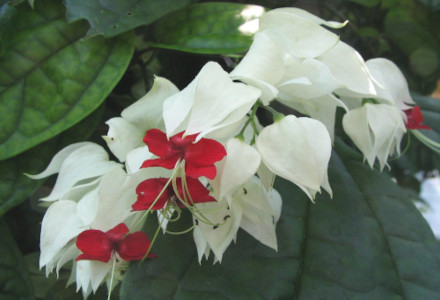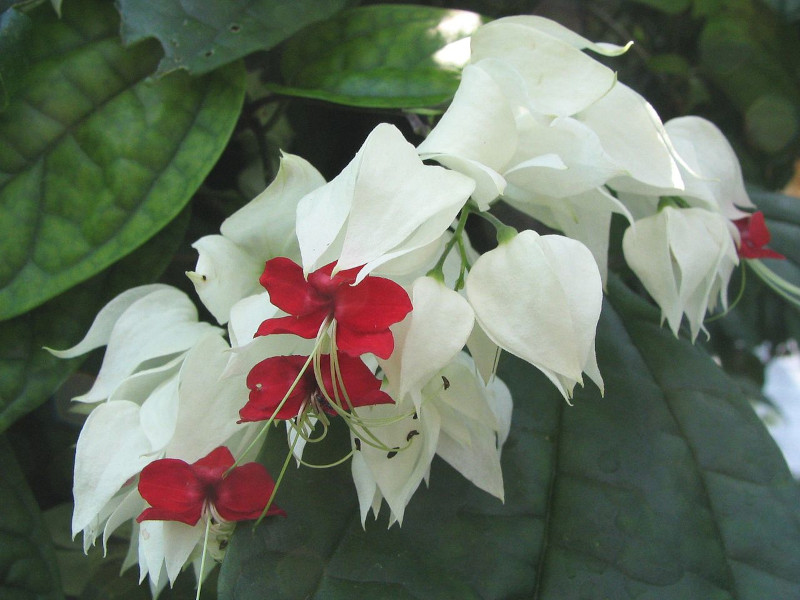Bleeding Heart Vine Facts
- Perhaps most notably, this magnificent product of Nature and evolution most frequently goes by common name of the Bleeding Heart Vine. Yet, it also has other, equally intriguing names. These include such terms as bleeding glory-bower and bag flower, among many others.
- Scientific professionals, meanwhile, tend to use its formal name when referring to it. That, however, is the extremely tongue-twisting term of Clerodendrum thomsoniae. Regardless of the particular term used, though, this wonderful flora remains a highly unique plant.
- As a result of its many amazing attributes, the astonishingly beautiful plant even gained the Award of Garden Merit from the Royal Horticultural Society. The species also continues to be extremely popular as an ornamental plant in much of the world, as it has for many years.
- Unfortunately, the vine does have factors working against it. That’s true since it requires a very specific combination of complex factors to survive. The root system must remain partially submerged in water the majority of the time. This flora also requires very direct light.
- The wonder also holds yet another surprise, however. The magnificent vine actually evolved as extremely hardy, despite the seeming frailty of the flowers. This surprising species also even managed to escape from cultivation in some areas and managed to become naturalized.
- For the moment, its numbers appear to be sufficient throughout its range. The IUCN therefore currently has no listing for the Bleeding Heart Vine on its published Red List at the moment. Nevertheless, it does face the potential threats created by the effects of climate change.
Related Articles
American Wisteria
Bleeding Heart Vine Physical Description
Don’t let the incredibly fascinating Bleeding Heart Vine beguile you, despite the fact it seems that’s exactly what Nature intended. Despite its simple-seeming appearance, the fabulous Angiosperm holds onto many secrets, much like many species. Some of these may even surprise you.
That’s because the species of flora actually constitutes something special. That’s an unusual species of evergreen vine. Yet it is important that it not be confused with another variety of plant. That’s due to the similarity of names between both it and another lovely plant named the Bleeding Heart.
The other forms an entirely different, if beautiful in its own right, species. This particular plant also evolved as a climbing variety which has the ability to reach heights equaling as much as 13 ft (4 m). The leaves of the gorgeous Bleeding Heart Vine also have their own brand of natural beauty.
In point of fact, that intriguing foliage generally manifest as both dark green and oval in shape. It further averages 7 in (17 cm) in length. Its most noteworthy feature though, likely remains the distinctive flowers. These beauties occur in bunches of 8-20 and appear on long, thin stalks.
Yet another distinctive feature of the Bleeding Heart Vine remains the remarkable pattern of its blooms colors. The outer portion ranges in color from stark white to a less common pale purple. However, the inner portion presents a brilliant red color, creating a breathtaking contrast.
- Kingdom: Plantae
- Phylum: Angiosperms
- Class: Eudicots
- Order: Lamiales
- Family: Verbenaceae
- Genus: Clerodendum
- Species: C. thomsoniae
Bleeding Heart Vine Distribution, Habitat, and Ecology
This marvel developed as native to a moderate habitat range. Not surprisingly, the Bleeding Heart Vine also originates from a region of the globe well known for its great natural beauty. That’s due to the fact that this wonder evolved as native to western portions of the continent of Africa.
There, this wonder of Nature currently grows in great abundance, and over a broad region. More specifically, it grows naturally in a range that includes Cameroon and Senegal. The plant also displays decidedly strong preferences, typically occuring naturally in regions of dense forest.
This stunning creation of evolutionary processes displays strong and clear preferences regarding its choice of habitat. Given the region of the world in which this amazing flora orginates, it understandably shows a clear favoritism for warm, moist tropical climates in which to appear.
Yet, thhis impressive Angiosperm also proves that it’s far more than just a beautiful species. That’s true because the plant also adapts surprisingly well to temperate climates in various parts of the world. Wherever it finds proper temperatures and light, along with fertile soils, it thrives.
The Bleeding Heart Vine primarily achieves its pollination via the actions of various butterflies, bees, and hummingbirds, in areas in which they occur. After pollination, the white calyces turn purple or violet as the fruit matures. Birds consume the fleshy fruits, later spreading the seeds via droppings.
This fascinating beauty also grows quite rapidly under ideal conditions. It evolved as a woody climber, not parasitic, using other plants as support but doesn’t harm them directly. In natural habitats, it contributes to vertical plant layering, offering shelter for insects and small animals.
Species Sharing Its Range
Check out our other articles on Wonderful Wild Cats of the World, Armored Sea Robin, Blood Falls, Kemps Ridley Sea Turtle, Indian Bullfrog, Multicolored Asian Lady Beetle, Socotra Dragon Tree


